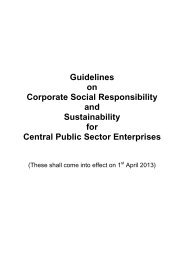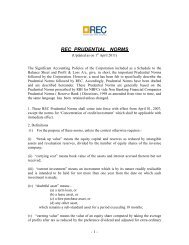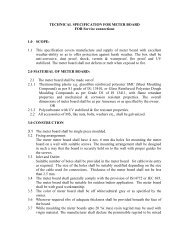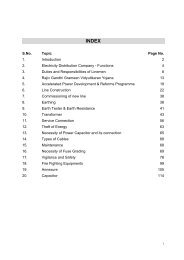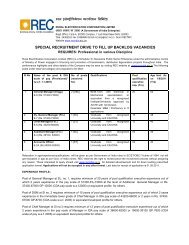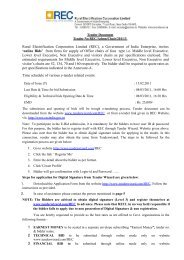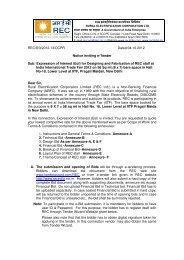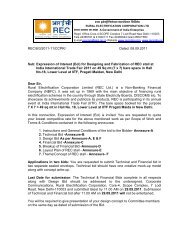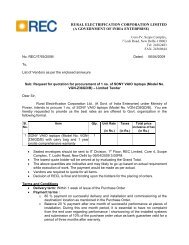REC- 1-51.p65 - Rural Electrification Corporation Ltd.
REC- 1-51.p65 - Rural Electrification Corporation Ltd.
REC- 1-51.p65 - Rural Electrification Corporation Ltd.
Create successful ePaper yourself
Turn your PDF publications into a flip-book with our unique Google optimized e-Paper software.
RURAL ELECTRIFICATION CORPORATION LIMITED<br />
Chairman’s letter to Shareholders<br />
Ladies and Gentlemen,<br />
On behalf of the Board of Directors of <strong>Rural</strong> <strong>Electrification</strong> <strong>Corporation</strong> <strong>Ltd</strong>. (<strong>REC</strong>) and on my own behalf, I<br />
am happy to welcome you on the occasion of the Forty First Annual General Meeting of the Company.<br />
I assumed charge as the Chairman and Managing Director of the Company on 15th June 2010 and I am<br />
privileged to be heading a Nav Ratna Company which has many more accolades to its credit besides<br />
establishing a record of excellent all-round performance, consistent growth and profitability, especially<br />
over the last three years. I am happy to inform you that your Company is now amongst top fifty companies<br />
of the country based on market cap with YTD performance till July 9, 2010.<br />
I wish to recall, in retrospect, that the Company was set up 41 years ago in July 1969, in the backdrop of a<br />
critical draught situation facing the country in the late sixties. The Company’s initial mandate was mainly<br />
to finance rural electrification schemes in the country to accelerate the pace of rural electrification in the<br />
overall context of planned programmes for increased agricultural production. Thus, from its humble<br />
beginnings of financing rural/village electrification and pumpset energisation schemes, the Company has grown in geometric progression,<br />
especially in the last decade, to become one of the leading public financial institutions in the country, financing all kinds of power projects<br />
without any restrictions.<br />
The tremendous growth in the size, volume and scale of operations of the Company in such magnitude would not have been possible but<br />
for the untiring efforts put in by all my predecessors over the years, including my immediate predecessor Shri P. Uma Shankar, to steer the<br />
Company in a dedicated manner with great sense of vision, mission and farsightedness, with active and consistent support from all the<br />
concerned agencies of the Government of India, led by the Ministry of Power, with the support and cooperation of all employees and other<br />
stakeholders of the Company. I would like to take this opportunity to sincerely thank and applaud all their efforts in making this Company<br />
a ‘behemoth’ organisation in its own way, with Gross Loan Assets of around Rs.66,000 crore as on 31.3.2010 and current market capitalisation<br />
hovering around Rs.30,000 crore, to be reckoned with by domestic as well as global investing community and all other stakeholders.<br />
FURTHER PUBLIC OFFERING (FPO)<br />
Within two years of receiving phenomenal response to the Initial Public Offering (IPO) of the Company, <strong>REC</strong> went for a Further Public<br />
Offering (FPO) of 17,17,32,000 Equity Shares in February 2010, which also included Offer for Sale of 4,29,33,000 Equity Shares by the<br />
Government of India, at a price determined through the Alternate Book Building Method as per SEBI Regulations, to further increase the<br />
Company’s net worth and expand its lending capacity. In spite of the uncertain conditions in the capital market, there was overwhelming<br />
response for the FPO also, especially from Qualified Institutional Buyers (QIBs) including Foreign Institutional Investors (FIIs), and the<br />
FPO got subscribed 3.14 times. The total amount raised by the Company, including premium, from the Fresh Issue of Shares in FPO was<br />
Rs. 2647.53 crore, which has been utilised for the business of the Company as mentioned in the Prospectus.<br />
ECONOMIC ENVIRONMENT<br />
The world economy has been through a severe recession marked by financial turmoil, large-scale destruction of wealth, and declines in<br />
global output and trade. The global crisis, which began in the financial sector in the developed countries, exposed a number of fragilities<br />
within the increasingly integrated financial system and affected the economy. Global economic conditions however appear to have improved<br />
on the strength of co-ordinated fiscal and monetary policy measures taken by governments and central banks across the world. With<br />
stimulant packages introduced by various governments the world economic situation is steadily improving since the second quarter of<br />
2009 with an increasing number of countries registering positive quarterly growth in their Gross Domestic Product (GDP).<br />
In the case of Indian economy, there is a trend of strong GDP growth expected at 7.2% in FY 2010, rising to over 8% in FY 2011 and moving<br />
on to 9-10% in the medium term. At the same time, inflation is rising. This complex global and domestic economic backdrop has posed its<br />
own set of challenges for policymakers including maintaining interest rates in sync with global rates, while supporting the growth momentum<br />
and also keeping a check on inflation.<br />
POWER SECTOR<br />
During the first three years of the XI Five Year Plan, the installed generation capacity has grown from 132.33 GW at the end of fiscal 2007<br />
to 159.4 GW at the end of fiscal 2010 representing an addition of 27068 MW. The target of capacity addition during the XI Plan has been<br />
kept at 78700 MW.<br />
According to the Report of the Working Group on Power for XI Plan of the Government of India, the overall requirement of funds for the<br />
power sector has been estimated at Rs. 10,316,000 million. For the XII Plan period, CEA estimates that in order to meet the projected<br />
demand requirement by 2017, capacity addition of 100,000 MW would be required; and including additions required in expanding<br />
transmission and distribution systems, the total fund requirement for the plan period would be about Rs. 11,000,000 million.<br />
Investments for transmission system development and related schemes during the XI Plan period is estimated at Rs. 1,400,000 million,<br />
with Rs. 750,000 million being required for the central sector and Rs. 650,000 million being required for the state sector. Further, CEA<br />
estimates that in the XII Plan the funds requirement for transmission sector would be about Rs. 2,400,000 million, with Rs. 1,400,000<br />
million being required for the central sector and Rs. 1,000,000 million being required for the state sector.<br />
The total fund requirement for sub-transmission and distribution system development for urban and rural areas, during the XI Plan period<br />
is estimated at Rs. 2,870,000 million inclusive of APDRP and RGGVY schemes. Further, CEA estimates that for the XII Plan period, the<br />
total fund requirement for the Distribution sector would be about Rs. 3,710,000 million.<br />
The power sector is thus poised to remain vibrant and attract significant investments in the foreseeable future.<br />
5



